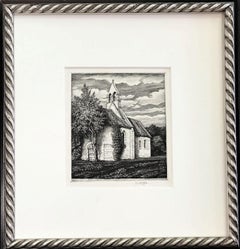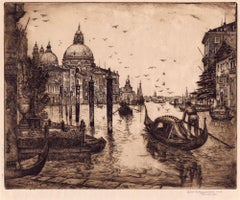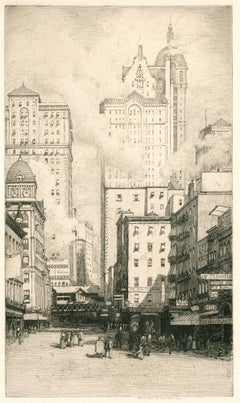Frederick Landseer Griggs, R.A., R.E. Art
British, 1876-1938
Frederick Maur Landseer Griggs was born in Hitchin, Hertfordshire, in 1876. He studied at the Slade School of Art and worked for two years 1896-8 in the architectural office of C.E. Mallows, the architectural draughtsman. He worked in a visionary tradition deriving from William Blake, Samuel Palmer, and Edward Calvert. Griggs created 57 prints in all, depicting idealized Gothic buildings and landscapes. He was Master of the Art Workers' Guild, and one of the first etchers to be elected to full membership of the Royal Academy.to
1
1
Overall Width
to
Overall Height
to
2
1
1
1
1
1
1
1
1
1
2
2
9,961
2,751
1,376
1,371
1
2
Artist: Frederick Landseer Griggs, R.A., R.E.
Netherton Chapel
By Frederick Landseer Griggs, R.A., R.E.
Located in Storrs, CT
Netherton Chapel. 1935. Etching. Comstock 53.v. 5 11/16 x 4 3/8 (sheet 8 15/16 x 6 1/2). Edition 85 in this state (total edition 88-89). Illustrated Fine Prints of the Year, 1936; Print Collector's Quarterly 26 (1939): 286. A fine impression on white laid paper with a partial crown watermark. Signed in pencil. Housed in a striking 11 1/2 x 10 7/8 wood and champagne gold frame.
According to Comstock "The subject is a small memorial chapel, now much more ruinous than the etching shows, near Bredon Hill...
Category
Mid-20th Century Modern Frederick Landseer Griggs, R.A., R.E. Art
Materials
Etching
$1,600 Sale Price
20% Off
Palace Court
By Frederick Landseer Griggs, R.A., R.E.
Located in New York, NY
Frederick Landseer Griggs (1876-1938), Palace Court, 1933, etching, signed and inscribed in pencil. Reference: Comstock 49, third state (of 3), from the printing of about 75. In exce...
Category
1930s Realist Frederick Landseer Griggs, R.A., R.E. Art
Materials
Etching
Related Items
The Grand Canal, Venice
By Elias S. Mandel Grossman
Located in Middletown, NY
1926. Etching in sepia ink on Japon paper, 9 5/8 x 11 1/2 inches (245 x 292 mm), full margins with the lower margin slightly notched. Signed, titled and dated in pencil in the lower ...
Category
Early 20th Century American Modern Frederick Landseer Griggs, R.A., R.E. Art
Materials
Handmade Paper, Etching
Cortland Street
Located in Middletown, NY
Etching with drypoint on antique handmade laid Japon paper, 12 7/8 x 7 1/2 (327 x 191 mm); sheet 15 5/16 x 10 7/16 (389 x 265 mm), full margins. Signed in pencil in the lower margin....
Category
Early 20th Century American Modern Frederick Landseer Griggs, R.A., R.E. Art
Materials
Drypoint, Etching
Chicago Skyline
By Paul Schumann
Located in Middletown, NY
A beautiful turn-of-the-century lake view of Chicago by an American artist known for his Texas landscapes.
Etching with drypoint on watermarked Umbria laid paper with deckle edges, 7 1/4 x 10 7/8 inches (182 x 275 mm), full margins. Signed and numbered 4/25 in pencil, lower margin. In good condition with adhesive residue at the sheet edges on the verso, does not show through to the recto. A lovely Lake Michigan landscape...
Category
Early 20th Century American Modern Frederick Landseer Griggs, R.A., R.E. Art
Materials
Handmade Paper, Etching, Drypoint
Cathedral de Saint Julien le Mans
By John Taylor Arms
Located in Middletown, NY
Etching on antique cream laid paper with a deckle edge, 9 1/8 x 9 3/4 inches (232 x 248 mm); sheet 12 1/8 x 12 3/4 inches (307 x 323 mm), full margins. Signed and dated in pencil in ...
Category
Early 20th Century American Modern Frederick Landseer Griggs, R.A., R.E. Art
Materials
Handmade Paper, Laid Paper, Etching
Chartres; Cathedral of Notre Dame from the River
By John Taylor Arms
Located in Middletown, NY
A superb impression on Japon paper, one of only three proofs.
Etching on handmade Japon paper with a deckle edge, 13 1/8 x 9 7/8 inches (333 x 252 mm); sheet 18 1/4 x 13 3/4 inches ...
Category
Early 20th Century American Modern Frederick Landseer Griggs, R.A., R.E. Art
Materials
Handmade Paper, Etching
'Old Cedars' – Early New Mexico Landscape, Southwest Regionalism
By George Elbert Burr
Located in Myrtle Beach, SC
George Elbert Burr, 'Old Cedars – New Mexico', etching, 1920, edition 40, Seeber 218. Signed and annotated '(c) George Elbert Burr Del. et Imp.' in pencil. ...
Category
1920s Realist Frederick Landseer Griggs, R.A., R.E. Art
Materials
Etching
$1,400
H 9.75 in W 11.75 in
LE PETIT CAVALIER SUR BOIS.
By Jean Baptiste Corot
Located in Santa Monica, CA
JEAN-BAPTISTE CAMILLE COROT (1876 - 1875)
LE PETIT CAVALIER SUR BOIS. 1854 (1921) (Delteil 42)
Cliché-verre on thin vellum. Signed in plate at bottom. 8 1/4 x 6 5/16” (sheet size)....
Category
1850s Realist Frederick Landseer Griggs, R.A., R.E. Art
Materials
Photographic Paper, Etching
Busy Street, Vienna
By Robert Kasimir
Located in San Francisco, CA
This artwork Busy Street, Vienna" c. 1970 is a color etching by noted Austrian artist Robert Kasimir, 1914-2002. It is signed at the lower center in penci...
Category
Late 20th Century Realist Frederick Landseer Griggs, R.A., R.E. Art
Materials
Etching
Venice Beach Seascape, Long Wave, Nautical Scene in Blue Tones, Limited Edition
By Kind of Cyan
Located in Barcelona, ES
This is an exclusive handprinted limited edition cyanotype.
This beautiful cyanotype is titled "Long Wave in Venice Beach" and it shows an outstanding wave in one of the most iconic ...
Category
2010s Realist Frederick Landseer Griggs, R.A., R.E. Art
Materials
Paper, Emulsion, Watercolor, Engraving, Etching, Monotype
Communipaw, NY; January Thaw
By Thomas Moran
Located in Middletown, NY
A delicate composition of an industrial Hudson River town, seen from lower Manhattan; a view of what is now Liberty State Park.
New York: 1884. Etching with aquatint on cream laid p...
Category
Late 19th Century Realist Frederick Landseer Griggs, R.A., R.E. Art
Materials
Laid Paper, Etching, Aquatint
Passaic Meadows (In the Newark Meadows)
By Thomas Moran
Located in Middletown, NY
Boston: American Art Review, 1880. Etching on cream laid paper, 5 3/4 x 8 3/4 inches (146 x 230mm), full margins. Light uniform age tone, scattered handling creases and minor toning ...
Category
Late 19th Century Realist Frederick Landseer Griggs, R.A., R.E. Art
Materials
Laid Paper, Etching
Cityscape
Located in San Francisco, CA
This artwork titled "Cityscape" c.1930 is an original color etching on wove paper by Austrian/American artist Tana Kasimir Hoernes, 1887-1972. It is hand signed in pencil by the artist. The image (plate mark) size is 12.75 x 9.15 inches, framed size is 19.35 x 15.25 inches. Custom framed in a silver with brown patina frame, with light grey matting and green and red filet. It is in excellent condition,
About the artist:
Tanna Kasimir...
Category
Mid-20th Century Realist Frederick Landseer Griggs, R.A., R.E. Art
Materials
Etching
Frederick Landseer Griggs, R.a., R.e. art for sale on 1stDibs.
Find a wide variety of authentic Frederick Landseer Griggs, R.A., R.E. art available for sale on 1stDibs. You can also browse by medium to find art by Frederick Landseer Griggs, R.A., R.E. in etching and more. Much of the original work by this artist or collective was created during the 20th century and is mostly associated with the Old Masters style. Not every interior allows for large Frederick Landseer Griggs, R.A., R.E. art, so small editions measuring 11 inches across are available. Customers who are interested in this artist might also find the work of Robin Tanner, John Webber, and James Carter. Frederick Landseer Griggs, R.A., R.E. art prices can differ depending upon medium, time period and other attributes. On 1stDibs, the price for these items starts at $1,600 and tops out at $2,250, while the average work can sell for $1,975.


